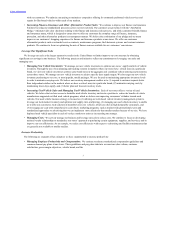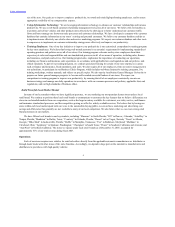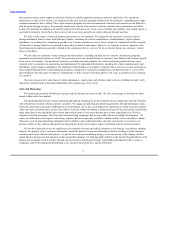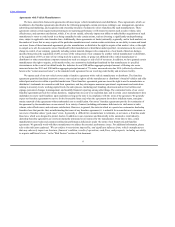AutoNation 2007 Annual Report Download - page 13
Download and view the complete annual report
Please find page 13 of the 2007 AutoNation annual report below. You can navigate through the pages in the report by either clicking on the pages listed below, or by using the keyword search tool below to find specific information within the annual report.
Table of Contents
performance, or achievements expressed or implied by the forward-looking statements. The risks, uncertainties, and other factors that our
stockholders and prospective investors should consider include, but are not limited to, the following:
The automotive retailing industry is sensitive to changing economic conditions and various other factors. Our business and results
of operations are substantially dependent on new vehicle sales levels in the United States and in our particular geographic markets
and the level of gross profit margins that we can achieve on our sales of new vehicles, all of which are very difficult to predict.
We believe that many factors affect sales of new vehicles and automotive retailers’ gross profit margins in the United States and in our
particular geographic markets, including the economy, inflation, recession or economic slowdown, consumer confidence, housing markets, fuel
prices, credit availability, the level of manufacturers’ production capacity, manufacturer incentives (and consumers’ reaction to such offers),
intense industry competition, interest rates, the prospects of war, other international conflicts or terrorist attacks, severe weather conditions, the
level of personal discretionary spending, product quality, affordability and innovation, employment/unemployment rates, the number of
consumers whose vehicle leases are expiring, and the length of consumer loans on existing vehicles. Changes in interest rates could significantly
impact industry new vehicle sales and vehicle affordability, due to the direct relationship between interest rates and monthly loan payments, a
critical factor for many vehicle buyers, and the impact interest rates can have on customers’ borrowing capacity and disposable income. If there
is a decline in the availability of credit, particularly in the sub-prime lending market, the ability of certain consumers to purchase vehicles could
be limited, resulting in a decline in sales or profits. Sales of certain new vehicles, particularly larger trucks and sports utility vehicles that
historically have provided us with higher gross margins, also could be impacted by fuel prices and the level of construction activity. In 2006
and 2007, new vehicle sales in the United States experienced a significant decline, driven in part by significant weakness in the housing
market, particularly in California and Florida. In 2007, approximately 50% of our new vehicle revenue was generated by our stores in
California and Florida. Continued weakness or a lengthy downturn in the housing market could materially adversely impact our sales.
Our new vehicle sales may differ from industry sales, due to particular economic conditions and other factors in the geographic markets in
which we operate. We expect new vehicle sales in the United States to decrease in 2008. A significant decrease in new vehicle sales levels in the
United States (or in our particular geographic markets) in the future, or a decrease in new vehicle gross profit margins, could cause our actual
earnings results to differ materially from our prior results and projected trends. Economic conditions and the other factors described above also
may materially adversely impact our sales of used vehicles, finance and vehicle protection products, vehicle service, and parts and repair
services.
We are dependent upon the success and continued financial viability of the vehicle manufacturers and distributors with which we
hold franchises.
The success of our stores is dependent on vehicle manufacturers in several key respects. First, we rely exclusively on the various vehicle
manufacturers for our new vehicle inventory. Our ability to sell new vehicles is dependent on a vehicle manufacturer’s ability to produce and
allocate to our stores an attractive, high quality, and desirable product mix at the right time in order to satisfy customer demand. Second,
manufacturers generally support their franchisees by providing direct financial assistance in various areas, including, among others, inventory
financing assistance and advertising assistance. Third, manufacturers provide product warranties and, in some cases, service contracts, to
customers. Our stores perform warranty and service contract work for vehicles under manufacturer product warranties and service contracts,
and direct bill the manufacturer as opposed to invoicing the store customer. At any particular time, we have significant receivables from
manufacturers for warranty and service work performed for customers. In addition, we rely on manufacturers to varying extents for original
equipment manufactured replacement parts, training, product brochures and point of sale materials, and other items for our stores.
The core brands of vehicles that we sell are manufactured by Toyota, Ford, General Motors, Honda, Nissan, Chrysler, Daimler, and
BMW. In particular, our Ford Motor Company and General Motors Corporation
11
























